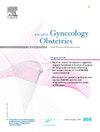原发性HPV筛查人群中阴性大环切除转化区(LLETZ)的预测因素。
IF 1.7
4区 医学
Q3 OBSTETRICS & GYNECOLOGY
Journal of gynecology obstetrics and human reproduction
Pub Date : 2025-01-17
DOI:10.1016/j.jogoh.2025.102913
引用次数: 0
摘要
目的:评估组织学阴性大环切除转化区(LLETZ)的比率和潜在的预测因素在一个英国阴道镜单位。设计:回顾性队列研究设置:英国谢菲尔德Jessop Wing阴道镜检查中心人群:在阴道镜检查数据库中编码为接受过LLETZ手术的患者。方法:单因素(卡方、t检验)和多因素logistic回归分析。主要观察指标:组织学阴性LLETZ样本。结果:2969例患者接受了LLETZ手术;291例(10%)手术导致LLETZ阴性。结论:由于HPV检测结合细胞学检测高级别疾病的敏感性增加,活检阳性后更有可能出现LLETZ阴性。这可能是由于仅通过穿刺活检检测到小体积高级别疾病,疾病自发消退或局部免疫反应和愈合而消退。由于年龄的增长和不满意的阴道镜检查是获得阴性LLETZ的重要危险因素,作者建议在这个更具挑战性的转诊人群中进行进一步的研究。本文章由计算机程序翻译,如有差异,请以英文原文为准。
Predictors for negative large loop excision of the transformation zone (LLETZ) in a primary HPV screened population
Objective
To assess rates of histologically negative large loop excisions of the transformation zone (LLETZ) and potential predictive factors within a single UK Colposcopy Unit.
Design
Retrospective cohort study.
Setting
Jessop Wing Colposcopy Unit, Sheffield, U.K.
Population
Patients coded upon the Colposcopy database as having undergone a LLETZ procedure.
Methods
Univariate (Chi squared, t-test) and multivariate logistic regression analysis.
Main outcome measures
Histological negative LLETZ sample.
Results
2,969 patients underwent a LLETZ procedure; 291 (10 %) procedures resulted in a negative LLETZ. Older age group (p < 0.0001), referral with negative cytology high risk human papillomavirus (hrHPV) detected (p < 0.0001), unsatisfactory colposcopy (p < 0.0001), repeat LLETZ (p < 0.0001), and biopsy and treat procedures (p = 0.0005) were found significant predictors of negative LLETZ. Patients with negative LLETZ were significantly less likely to have had a 'select & treat' procedure (p < 0.0001).
Conclusion
Due to the increased sensitivity of HPV testing in combination with cytology for the detection of high-grade disease, it is more likely a negative LLETZ will occur following positive biopsy. This may be due to the detection of small volume high-grade disease removed by the punch biopsy alone, spontaneous regression of disease, or resolution due to localised immune responses and healing. As increasing age and unsatisfactory colposcopy are significant risk factors for obtaining a negative LLETZ, the authors recommend further studies are conducted in this more challenging referral population.
求助全文
通过发布文献求助,成功后即可免费获取论文全文。
去求助
来源期刊

Journal of gynecology obstetrics and human reproduction
Medicine-Obstetrics and Gynecology
CiteScore
3.70
自引率
5.30%
发文量
210
审稿时长
31 days
期刊介绍:
Formerly known as Journal de Gynécologie Obstétrique et Biologie de la Reproduction, Journal of Gynecology Obstetrics and Human Reproduction is the official Academic publication of the French College of Obstetricians and Gynecologists (Collège National des Gynécologues et Obstétriciens Français / CNGOF).
J Gynecol Obstet Hum Reprod publishes monthly, in English, research papers and techniques in the fields of Gynecology, Obstetrics, Neonatology and Human Reproduction: (guest) editorials, original articles, reviews, updates, technical notes, case reports, letters to the editor and guidelines.
Original works include clinical or laboratory investigations and clinical or equipment reports. Reviews include narrative reviews, systematic reviews and meta-analyses.
 求助内容:
求助内容: 应助结果提醒方式:
应助结果提醒方式:


